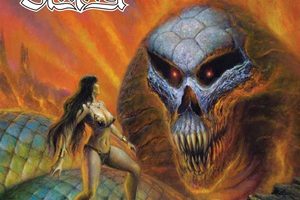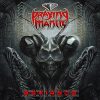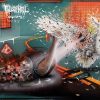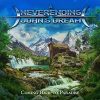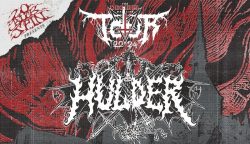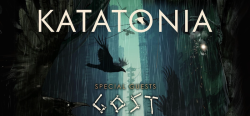Stälker – Conjuring Majik
Saturday, 12th December 2020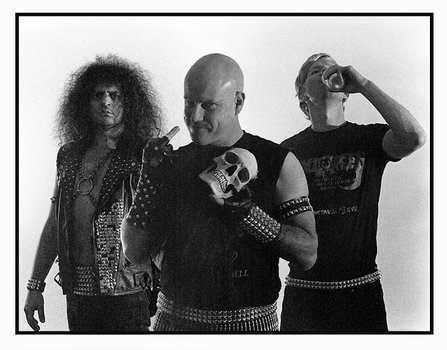
New Zealand isn’t world-renowned for their metal scene, but that’s where a band like Stälker hopes to change things up. Especially for those that love their heavy music fast and furious, featuring a bevy of speedy riffs and tempos, over the top vocals, and insanity not heard since the days of early Venom and Exciter. Their latest album Black Majik Terror conjures the fire and brimstone aesthetic that was a part of the 80’s underground – sure to satisfy many hordes of consumers who live for the cause. We reached out to guitarist Chris Calavrias and he was very happy to bring us up to speed on the new album, the songwriting process, outlook on the band’s speed metal template, plus thoughts on Iron Maiden, special shows in the Czech Republic, and future plans.
Dead Rhetoric: Black Majik Terror is the second Stälker studio album. Where do you see the major differences between your debut Shadow of the Sword from 2017 to this effort? How did the recording and songwriting sessions go for this material?
Chris Calavrias: That’s a good question. I’m struggling to think of a difference between the two albums. The songwriting process was the same. Myself and Dave live a couple of streets apart from each other and we are quite close. We are always in contact. In terms of songwriting, it’s a 50/50 split music-wise – he’ll finish some of my songs, I’ll finish some of his songs, he’ll add riffs to one of my songs and I’ll add riffs to his to get it to the finished state. Lyric-wise, we will come up with a melody or a chorus or something, and Dave will go off and finish the lyrics.
In terms of the sound, I think we spent a bit more time knowing what we wanted on this album more than last time. We worked with the same guys that worked on the first one, and mixed it. They got a better sense of what we wanted this time around, which was actually quite hard to find with people. I haven’t worked with too many people that have done recording and mixing, it’s quite hard to get what you want across without doing it yourself. Especially in a style that a lot of these guys are probably not used to working with. Does that make sense?
Dead Rhetoric: Definitely. Do you believe it’s a challenge to keep the sound crisp and clear because of the speed that you play at?
Calavrias: Definitely. I think it’s a challenge because they hadn’t done anything like this before. The second time around, everyone was on the same page as to what we wanted. They’ve had a year to think about our sound, where we wanted to go, we wanted to work with them. They went away and thought about things from their side about the final product.
Dead Rhetoric: The instrumental section of “Holocene’s End” has components that harken back to “Phantom of the Opera” from Iron Maiden to these ears. Are you as much a fan of the Di’Anno-era as Bruce Dickinson, and do you enjoy the differences in the playing of Adrian Smith to Dave Murray?
Calavrias: I am a huge Iron Maiden fan, and I am a huge fan of both Di’Anno and Bruce. I love the intensity and rawness of Di’Anno, but undeniably I am a Bruce guy because of the amount of albums that the Bruce-era has. It’s really hard to pick out of those albums which I like the most. In terms of Adrian Smith and Dave Murray, two of my favorite guitarists. I think I’m an Adrian kind of guy, not in terms of songwriting choice but the solos. I love his more melodic solos, absolutely huge influence for me even in my old band Razorwyre, which was more NWOBHM. I don’t get to do that much in this band, but when the time came in “Holocene’s End” it was a perfect time to let some Maiden worship flow onto the record without busting out of the restraints of our speed metal band.
Dead Rhetoric: You worked with New England artist Bob Eggleton, known for his work on numerous Godzilla books as well as illustration for Magic: The Gathering cards. How did you hook up with him, and tell us about the striking cover art he created this time?
Calavrias: Bob, we went through a couple of guys trying to find an artist early on. Sometimes these things can take a lot longer than you planned to take. We hooked up with a couple of younger artists who do the oil painting kind of style, we just didn’t really click with them past the first draft stage. And that’s cool, that happens. It’s just knowing the artist a bit more than hitting them up, let’s see how we gel. It ended up not working out for the newer artists, whether it was artistic differences or what we wanted they couldn’t really get across. We were more than happy to say it was more for someone else. I went back to the drawing board to look for one of the original artists that did that painting style from the 70’s or the 80’s. I had a little look and I found Bob. Some of the reference material I had for the cover was from Bob, I didn’t know who the artist was so that came back full circle. I reached out to Bob, I didn’t know if he was still doing art, but now I know how much he still does. It’s a long shot, would you be interested in doing some work? He reached back and was very enthusiastic to do this, he was over the moon and more stoked to do this for us. He was doing commissions and still painting a lot, he just turned 60 a couple of months ago, which is good.
He was very happy to do his first record cover and a vinyl cover. Every time I work with a cover artist I learn a bit more about how the process works. To make things a little easier I did a photoshop montage of what we were thinking of and looking at his past work, wrapped into a new piece. He was happy with it, we went back and forth with ideas to flesh it out a little bit. It was originally going to be a 12-inch square cover on the front, but Bob recommended the wrap-around gatefold cover and that worked out quite well for us.
In terms of what the cover means. This is more Dave’s department, basically the cover represents half the tracks ideas on the cover. Kind of like one of those Maiden covers where you can relate back to it when you are reading the lyrics to the songs. We’ve got the Queen of “Black Majik Terror” on the front, she’s raising a big monster. Be careful what you wish for and what you conjure up. The rest is up to the viewers and their imaginations.
Dead Rhetoric: When it came to shooting the videos for this record, I understand there was some controversy regarding the content for “Intruder”, where there had to be a second video because of the mature nature that YouTube deemed not suitable under the age of 18?
Calavrais: At the start of this process of doing these singles, they wanted two videos and a lyric video. I’m not a big fan of lyric videos, just because of the way they are and the style they portray. So we banged out three videos, and that was quite a lot for us. A lot of time and a lot of money. This time around we thought how can we do some interesting videos on a low budget? The “Intruder” video was filmed at a landfill, there’s an industrial landfill in our hometown of Wellington and one of our friends goes there for work. They turned out to be really cool, we did what we wanted that day. The owner of the landfill is actually driving the car around the day, you can see him in the video. We thought about what else can we put in there. Our cameraman had a hernia operation in 2001 that he took a camera to the operation, he asked the doctor to plug it in and film the operation, on his balls. He had it done when he was skateboarding back then. We thought this would be cool and see what it looks it like. We watched it and thought we could cut it in the video. Didn’t realize all the problems that YouTube may have with censoring it – everything is always last minute with these videos. Napalm got it a couple of days before the release, and they had a massive problem uploading it. It ended up bringing their whole YouTube channel down for a little bit.
We made the censored video just in case. YouTube ended up allowing the video on as long as you verify that you are 18 years of age by signing it. I didn’t even think about this type of stuff.
Dead Rhetoric: As a three-piece focused on the speedier side of metal, how do you know what makes an ideal Stälker song – and what do you try to achieve when it comes to your riffs and lead breaks?
Calavrais: Because we are only a three-piece, it can work to your advantage and it can also be quite hard. You’ve got nothing to hide behind, and when you are doing your solos you’ve got no rhythms that you may have on the album. I have no problem with the album being different than the live setting. We try to keep things as close as possible to a three-piece sound. I think so far we’ve achieved that – even in a live setting I’ve had a couple of people come up to me they’ve said seeing us play and they wouldn’t even think that it’s a three-piece, it sounded so big. It’s really good to hear, I think it’s because our bass sound is so big it’s almost like a second guitar.
In terms of approaching the songs, we go into the songwriting with the three-piece sound in mind. We don’t want any false kind of sound that you won’t get live. In terms of what I’m trying to get across with the riffs and solos. I guess they are trying to compliment each other. I read a review recently that said the solos even ramp up the songs up more. We want to keep the pace up. It’s such fast music that there is a lot of atonal sound in the solos, where you have notes out of the scale, and you have some melodic-type stuff. Each song is different for the solo, just fast and furious is the first thing we think of when it comes to the music writing.
Dead Rhetoric: What have been some of the most memorable shows or tours that Stälker has done to date? And do you believe the audience feeds off the over the top insanity that you display in many of your songs – energizing the band members on stage even more?
Calavrais: 100% definitely. There is nothing worse than a timid, mild show. It does happen, but once the crowd starts to get involved it amps me up twofold. I’m an energetic player, and having Dave with me now too, we feed off each other and the audience. We have a bit more room to move around. From the get go, I’ll be energized. In terms of memorable shows, we were really lucky to get to Europe the last two years. Some of those shows are absolutely insane. I don’t know if it’s something in the water in some of these cities, but the place that comes to mind always is the Czech Republic. There’s a little place called Pasic an hour out of Prague, they have an awesome DIY scene.
They have a crew called the Thrash Nightmare crew. They’ve got about three little mini-festivals a year. We take part in their Speed Metal Attack festival, they have a Heavy Metal Thunder one which is geared towards NWOBHM and then Thrash Nightmare fest which is the death metal kind of thing. You go there, and everyone is there from early on. They are drinking right away in the car park, the beer is cheaper than water which blows my mind. Keeping up with these guys, they go absolutely crazy. I’ve got a couple of clips that I’ve posted up online – I’ve got a live montage that I am working on for another single and you’ll see some of that footage in there. Hanging from the ceiling, hanging from the air ducts, very crazy. Maybe it might be something in their town and the way they grew up, they are looking for a release and it’s just fantastic.
Dead Rhetoric: What can you tell us about the New Zealand metal scene – do you believe you receive proper respect and support from the fans, fellow bands, venues, and promoters – or is it a situation where your style is more well-accepted in other parts of the world?
Calavrais: Definitely I’ll start with the second part. I feel more appreciated not as a band but as a style of music in other parts of the world. Europe, everyone is appreciated there, having those scenes in each city that are healthy enough to bring bands over and have a scene show up at the show to make it worthwhile for the bands, fans, and the promoter is just perfect. In New Zealand we are in the ass end of the world, very far away from everything. We get influence from America and Europe, but we don’t have those heavy metal scenes because of our sheer population numbers. In spite of that, we have a healthy and active metal scene – everyone knows everyone.
We have a Facebook metal group, and there is only room for one thing – heavy metal as a whole. You have black metal, stoner, doom, punk, heavy metal all under the one umbrella. The bad side of that is you don’t have a die-hard, core scene following one style. You aren’t going to get one hundred thrash kids all showing up in their battle jackets, it’s not going to be like that. It will be all kind of genre fans – and they are mixed genre shows. There isn’t even three thrash bands in the country. Even in Australia with a bigger population, they don’t have a dedicated thrash scene either. Maybe Europe, they just seem to have always had a lot of bands and love all things heavy metal.
Dead Rhetoric: How do you feel about the physical mediums when it comes to heavy metal versus digital/streaming platforms? Because of your old school ethics and style, I would think that you love vinyl, cassettes, and CD’s…?
Calavrias: Me as a fan, I grew up with CD’s, tapes, vinyl was a new thing for me. I’ve got my own small collection of vinyl I’ve been given, and CD’s and tapes from going on tour and buying from bands I like. It’s very important for the fans, to have that stuff out. We are lucky to be in a scene where the majority of people, over half are metalheads and collectors. It works in our favor. They own the albums and listen to what they’ve got. Trying to get people to stream has been difficult. That’s new for us, and we have claimed our Spotify artist account. It’s a crazy world as a band trying to maintain and monitor all these things. I was on there the other day, ads were coming up all the time but it wasn’t letting me choose my tracks.
Dead Rhetoric: You are on Napalm Records – which has a diverse roster that includes Evil Invaders, Grave Digger, and Legion of the Damned among others. How do you feel about their support, their staff, and their understanding of what Stälker is trying to achieve?
Calavrias: It’s a bit of a funny one, Napalm Records. As you said, a very diverse roster. Once you get to a major label, Napalm is that in heavy metal terms – you are going to get that diversity, it comes with the territory. You look at the big labels like Metal Blade, Nuclear Blast, they have a wide range of diversity in heavy metal. Evil Invaders, if it wasn’t for them I think some of the bands coming on now wouldn’t be gaining interest. In terms of support, they have been absolutely fantastic and been great to work with since day one. Awesome staff, everyone I have met has been super nice, friendly, and supportive. All of them love the label and put their hearts into it, working with professionals. The only other person I’ve worked with is Underground Power Records, and they were also a class act. Napalm has more resources and more time to do things. It’s not putting down any small labels. Napalm were willing to work with that small label as I wanted to still keep one foot in the underground, as we are an underground band. They let them have a color of a record all to themselves, which was awesome.
I’m blown away by their support. Just because you are on a major doesn’t mean you are going to go out there and sell thousands and thousands more records. Your band is only as big as your band can get, especially in an underground sense. If that makes any sense. You are only going to be as good and as big as your band is. If you are more a mainstream band, you don’t have to be as good and you can sell quite a lot because of the area you are in.
Dead Rhetoric: What do you think is the toughest thing to get metal followers of today to accept, considering many of your inspirations and viewpoints for the band are well-rooted in the 1980’s?
Calavrias: It’s more spreading the word. You think the world revolves around Facebook and that reach, but I was always under the impression that if you are into this style of music, then you are looking for other bands, following the pages. If you are good, you know about it in the scene. In interviews with people like yourselves, there are a lot of people that are stoked on this record and it’s the first time they’ve heard us. They have the same love and influences as us, it’s not surprising but there are still a lot of people out there to get this record in front of that don’t know of this kind of music. It’s a hard thing because you don’t know where to push it, but I think word of mouth in general is the best way.
This record is not for everyone, obviously. The people that love the diehard 80’s stuff, or the fast and furious stuff, I think they are going to love this album from the get go. I’m quite surprised about a lot of these people how much they love it, and that they’ve just heard of the band now. That just comes with time and the catalog. When you have only one album, you can’t expect too much. Having two albums out, that’s twice as much material, and I can’t wait to get another one to get out to more people.
Dead Rhetoric: Speed metal is a specific niche within the thrash scene – so it has a special appeal.
Calavrias: Definitely special and limited, yes! (laughs)
Dead Rhetoric: What sort of goals does the band set – or do you just try to take things on a case by case, day by day basis to achieve more of what you want?
Calavrias: At the moment we don’t really have goals, but we do break it down into smaller segments. There are only really a couple of goals. The first goal is to always have another album out. My first goal was to have this out last year, but I was a bit ahead of myself thinking how long these things take. You have a long time to create the first album, and then you don’t have as much time to get the next one out in a reasonable amount of time. I learned my lesson with my old band, it’s an experience thing. My goal is to have something out every year. That’s a good amount of things coming out. If you look at a band like Iron Maiden, I don’t understand how they did so much good work and so much quality music every single year: 1980, 1981, 1982, 1983, while on tour with no other jobs. We work full-time, and the stuff is done in the evenings. It can take two or three years. The thing that held us back is all the tour planning and going away, that’s behind the scenes that takes a while.
The goal is to get another one out by early 2022, that gives us a year and a bit.
Dead Rhetoric: What’s on the horizon for the next year or two for Stälker? Will there be another special 7” or possible cover releases in the pipeline, considering the lack of regular touring due to the pandemic?
Calavrias: We have some loose plans on the horizon. We want to ramp up what’s going on, and we have a couple of things in terms of videos we want to get out. As soon as this is over, I can’t wait to jump back in and write more riffs and work on stuff from last year. I haven’t had much time to play guitar, I’ve been busy with this release just to keep on top of everything. Definitely we have a few things planned for next year. You may see more stuff coming out from a lot of bands because of this pandemic.
We locked down early because of our location. We have no borders, we saw what was going on in the world. We did the right steps, we were able to come out pretty quick to get back to normal. We had a second wave come, some community transmission cases, only a small part locked down. We had restricted concert numbers for a month, but we have been in the clear for a couple of months now. No restrictions, and we are really fortunate to have that at the moment. It really takes it out of you when you are on lockdown.











